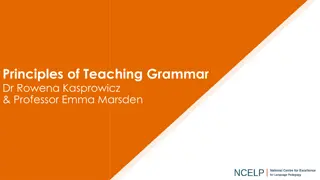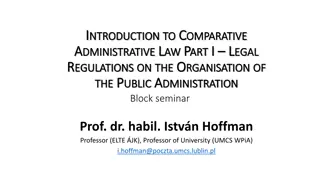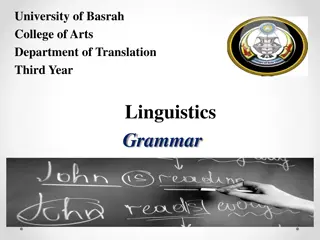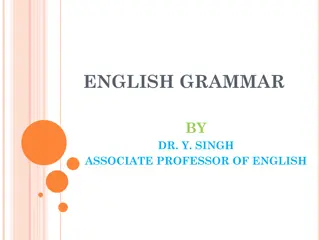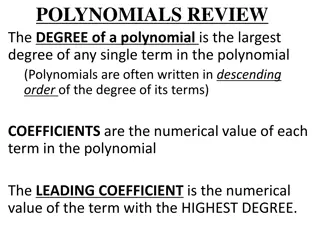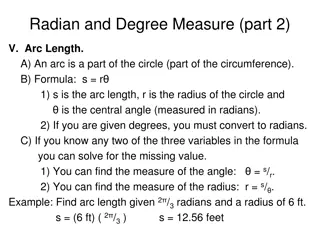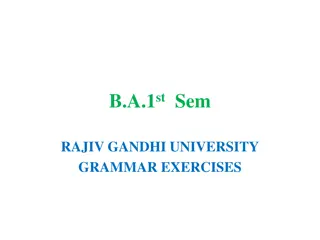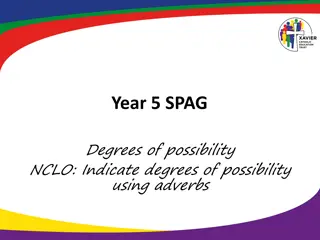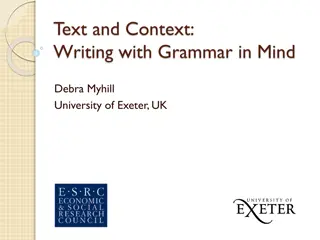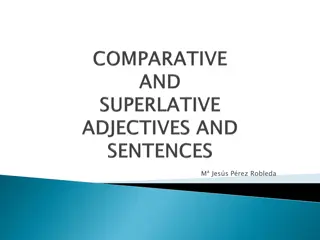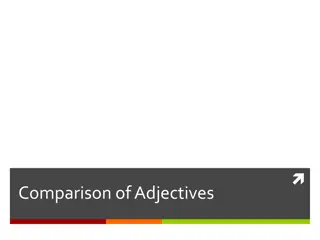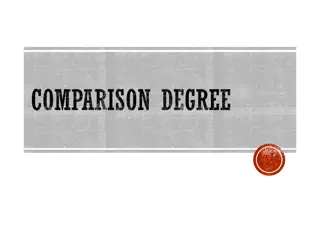Understanding Degrees of Comparison in English Grammar
Degrees of comparison in English grammar refer to the different forms of adjectives and adverbs used to indicate the level of comparison between different qualities. This includes the positive degree for basic descriptions, the comparative degree for comparing two things, and the superlative degree for comparing more than two things. By adding specific suffixes or modifying the base form of adjectives, we can change the degree of comparison while maintaining the sentence's meaning.
Download Presentation

Please find below an Image/Link to download the presentation.
The content on the website is provided AS IS for your information and personal use only. It may not be sold, licensed, or shared on other websites without obtaining consent from the author. Download presentation by click this link. If you encounter any issues during the download, it is possible that the publisher has removed the file from their server.
E N D
Presentation Transcript
DEGREES OF COMPARISON It is possible to change the Degree of Comparison of an Adjective or Adverb in a sentence, without changing the meaning of the sentence. Comparison can be made using the three forms of the adjective. Positive Comparative Superlative
POSITIVE DEGREE The Positive Degree of an adjective in comparison is the adjective in its simple form. It is used to denote the mere existence of some quality of what we speak about. It is used when no comparison is made. It is a tall building. Apple is sweet to taste. Mina is a nice girl.
COMPARATIVE DEGREE The Comparative Degree denotes the existence of a higher degree of the quality than the positive. It is used when two things (or two sets of things) are compared. This building is taller than any other building. Apple is sweeter than pear. Mina is nicer than most other girls in class .
SUPERLATIVE DEGREE The Superlative Degree denotes the existence of the highest degree of the quality. It is used when more than two things are compared. This is the tallest building. Apple is the sweetest fruit. Mina is one of the nicest girls in the class.
LIST OF DEGREES OF COMPARISON By adding er and est POSITIVE COMPARATIVE SUPERLATIVE bright brighter brightest black blacker blackest bold bolder boldest clever cleverer cleverest cold colder coldest fast faster fastest great greater greatest high higher highest kind kinder kindest
LIST OF DEGREES OF COMPARISON By adding r and st POSITIVE COMPARATIVE SUPERLATIVE brave braver bravest fine finer finest large larger largest nice nicer nicest noble nobler noblest pale paler palest simple simpler simplest wise wiser wisest white whiter whitest
LIST OF DEGREES OF COMPARISON By deleting the final y and adding ier and iest POSITIVE COMPARATIVE SUPERLATIVE costly costlier costliest dry drier driest easy easier easiest happy happier happiest heavy heavier heaviest lazy lasier lasiest merry merrier merriest wealthy wealthier wealthiest
LIST OF DEGREES OF COMPARISON By doubling the final consonants POSITIVE COMPARATIVE SUPERLATIVE big bigger biggest dim dimmer dimmest fat fatter fattest hot hotter hottest thin thinner thinnest
LIST OF DEGREES OF COMPARISON By using more and most POSITIVE COMPARATIVE SUPERLATIVE active more active most active attractive more attractive most attractive beautiful more beautiful most beautiful brilliant more brilliant most brilliant careful more careful most careful courageous more courageous most courageous cunning more cunning most cunning difficult more difficult most difficult famous more famous most famous faithful more faithful most faithful
LIST OF DEGREES OF COMPARISON Irregular Comparisons POSITIVE SUPERLATIVE COMPARATIV E bad worse worst evil worse worst good better best ill worse worst far farther farthest well better best late later latest little less least much more most many more most
CHANGES IN DEGREES OF COMPARISON Here more than two persons or places or things are compared. Matchless comparisons are of this type: Superlative Comparative Positive Iron is the most useful of all metals. Iron is more useful than any other metal. No other metal is so useful as iron. Tom is cleverer than any other boy in the class. No other boy in the class is so clever as Tom. Tom is the cleverest of all boys in the class. Rain water is the purest water. Rain water is purer than any other water. No other water is so pure as rain water.
CHANGES IN DEGREES OF COMPARISON Here more than two persons or places or things are compared. Generally this type is in plural form: Superlative Comparative Positive Iron is the most useful of all metals. Iron is more useful than any other metal. No other metal is so useful as iron. Cheetah is one of the fastest animals. Cheetah is faster than most other animals. Very few animals are as fast as cheetah. Food ball is one of the most interesting games. Foot ball is more interesting than most other games. Very few games are as interesting as foot ball.
CHANGES IN DEGREES OF COMPARISON Here only two persons or places or things are compared. For this type, there is no superlative form: Comparative Positive Paris is hotter than England. England is not so hot as Paris. The Blue Mountain Express runs faster than the Green Express. The Green Express does not run so fast as the Blue Mountain Express. Positive Comparative John is as tall as David. David is not taller than John.
COMPARISONS AND CONTRASTS 1. When we compare two objects, persons, qualities, degrees etc. that are some respects equal, we may use the comparison of equality. This is formed by the use of as... adjective / adverb... As Your house is as large as mine. 2. When we compare unequal subjects, we may use the comparative degree of the adjective or adverb with than His new book is more interesting than his earlier books. 3. When the comparison is negative, we use so... adjective / adverb... as Your house is not quite so large as mine.
COMPARISONS AND CONTRASTS 4. In some adverbial clauses of comparison both subject and verb are dropped. He is more shy than (he is) unsocial. Some people think more about their rights than (they do) about their duties. 5. In clauses of comparison introduced by than that should is used. I am already to do the work myself rather than that you should have to do it. 6. Comparison and contrast are also expressed by the use of the...the...with comparatives. The sooner you start, the sooner you ll finish. The more he read, the less he understood.
NOW TAKE THE ASSESSMENT ON DEGREES OF COMPARISON!



